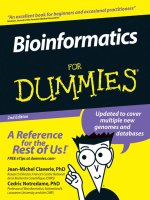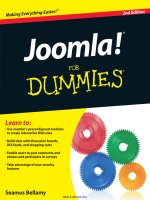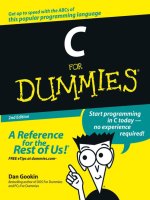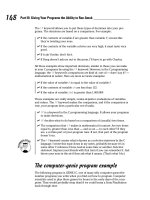Bioinformatics for dummies 2nd edition
Bạn đang xem bản rút gọn của tài liệu. Xem và tải ngay bản đầy đủ của tài liệu tại đây (13.84 MB, 457 trang )
Bioinformatics
FOR
DUMmIES
2ND
‰
EDITION
by Jean-Michel Claverie, PhD
and Cedric Notredame, PhD
Bioinformatics
FOR
DUMmIES
2ND
‰
EDITION
Bioinformatics
FOR
DUMmIES
2ND
‰
EDITION
by Jean-Michel Claverie, PhD
and Cedric Notredame, PhD
Bioinformatics For Dummies®, 2nd Edition
Published by
Wiley Publishing, Inc.
111 River Street
Hoboken, NJ 07030-5774
www.wiley.com
Copyright © 2007 by Wiley Publishing, Inc., Indianapolis, Indiana
Published by Wiley Publishing, Inc., Indianapolis, Indiana
Published simultaneously in Canada
No part of this publication may be reproduced, stored in a retrieval system or transmitted in any form or
by any means, electronic, mechanical, photocopying, recording, scanning or otherwise, except as permitted under Sections 107 or 108 of the 1976 United States Copyright Act, without either the prior written
permission of the Publisher, or authorization through payment of the appropriate per-copy fee to the
Copyright Clearance Center, 222 Rosewood Drive, Danvers, MA 01923, (978) 750-8400, fax (978) 646-8600.
Requests to the Publisher for permission should be addressed to the Legal Department, Wiley Publishing,
Inc., 10475 Crosspoint Blvd., Indianapolis, IN 46256, (317) 572-3447, fax (317) 572-4355, or online at
/>Trademarks: Wiley, the Wiley Publishing logo, For Dummies, the Dummies Man logo, A Reference for the
Rest of Us!, The Dummies Way, Dummies Daily, The Fun and Easy Way, Dummies.com, and related trade
dress are trademarks or registered trademarks of John Wiley & Sons, Inc. and/or its affiliates in the United
States and other countries, and may not be used without written permission. All other trademarks are the
property of their respective owners. Wiley Publishing, Inc., is not associated with any product or vendor
mentioned in this book.
LIMIT OF LIABILITY/DISCLAIMER OF WARRANTY: THE PUBLISHER AND THE AUTHOR MAKE NO REPRESENTATIONS OR WARRANTIES WITH RESPECT TO THE ACCURACY OR COMPLETENESS OF THE
CONTENTS OF THIS WORK AND SPECIFICALLY DISCLAIM ALL WARRANTIES, INCLUDING WITHOUT
LIMITATION WARRANTIES OF FITNESS FOR A PARTICULAR PURPOSE. NO WARRANTY MAY BE CREATED OR EXTENDED BY SALES OR PROMOTIONAL MATERIALS. THE ADVICE AND STRATEGIES CONTAINED HEREIN MAY NOT BE SUITABLE FOR EVERY SITUATION. THIS WORK IS SOLD WITH THE
UNDERSTANDING THAT THE PUBLISHER IS NOT ENGAGED IN RENDERING LEGAL, ACCOUNTING, OR
OTHER PROFESSIONAL SERVICES. IF PROFESSIONAL ASSISTANCE IS REQUIRED, THE SERVICES OF A
COMPETENT PROFESSIONAL PERSON SHOULD BE SOUGHT. NEITHER THE PUBLISHER NOR THE
AUTHOR SHALL BE LIABLE FOR DAMAGES ARISING HEREFROM. THE FACT THAT AN ORGANIZATION
OR WEBSITE IS REFERRED TO IN THIS WORK AS A CITATION AND/OR A POTENTIAL SOURCE OF FURTHER INFORMATION DOES NOT MEAN THAT THE AUTHOR OR THE PUBLISHER ENDORSES THE
INFORMATION THE ORGANIZATION OR WEBSITE MAY PROVIDE OR RECOMMENDATIONS IT MAY
MAKE. FURTHER, READERS SHOULD BE AWARE THAT INTERNET WEBSITES LISTED IN THIS WORK
MAY HAVE CHANGED OR DISAPPEARED BETWEEN WHEN THIS WORK WAS WRITTEN AND WHEN IT
IS READ.
For general information on our other products and services, please contact our Customer Care
Department within the U.S. at 800-762-2974, outside the U.S. at 317-572-3993, or fax 317-572-4002.
For technical support, please visit www.wiley.com/techsupport.
Wiley also publishes its books in a variety of electronic formats. Some content that appears in print may
not be available in electronic books.
Library of Congress Control Number: 2006934844
ISBN13: 978-0-470-08985-9
ISBN10: 0-470-08985-7
Manufactured in the United States of America
10 9 8 7 6 5 4 3 2 1
1B/SX/RR/QW/IN
About the Authors
Jean-Michel Claverie is Professor of Medical Bioinformatics at
the School of Medicine of the Université de la Méditerranée, and a
consultant in genomics and bioinformatics. He is the founder and
current head of the Structural & Genomic Information Laboratory,
located in Marseilles, a sunny city on the Mediterranean coast of
France. Using science as a pretext to travel, Jean-Michel has held
positions in Paris (France), Sherbrooke (PQ, Canada), the Salk
Institute (La Jolla, CA), the Pasteur Institute (Paris), Incyte pharmaceutical (Palo Alto, CA); and the National Center for Biotechnology
Information (Bethesda, MD). He has used computers in biology
since the early days –– his Ph.D. work involved modeling biochemical reactions by programming an 8K Honeywell 516 computer right
from the console switches! Although he has no clear recollection of
it, he has been credited with introducing the French word “bioinformatique” in the late eighties, before involuntarily coining the catchy
“bioinformatics” by mistranslating it while giving a talk in English!
Jean-Michel’s current research interests are in microbial and structural genomics, and in the development of bioinformatic methods
for the prediction of gene function. He is the author or coauthor of
more than 150 scientific publications, and a member of numerous
international review panels and scientific councils. In his spare
time, he enjoys the relaxed pace of life in Marseilles, with his wife
Chantal and their two sons, Nicholas and Raphael.
Cedric Notredame is a researcher at the French National Centre
for Scientific Research. Cedric has used and abused the facilities
offered by science to wander around Europe. After a Ph.D. at EMBL
(Heidelberg, Germany) and at the European Bioinformatics
Institute (Cambridge, UK) under the supervision of Des Higgins
(yes, the ClustalW guy), Cedric did a post-doc at the National
Institute of Medical Research (London, UK), in the lab of Willie
Taylor and under the supervision of Jaap Heringa. He then did a
post-doc in Lausanne (Switzerland) with Phillip Bucher, and
remained involved with the Swiss Institute of Bioinformatics for
several years. Having had his share of rain, snow, and wind, Cedric
has finally settled in Marseilles, where the sun and the sea are
simply warmer than any other place he has lived in.
Cedric dedicates most of his research to the multiple sequence
alignment problem and its many applications in biology. His
friends claim that his entire life (past, present, future) is somehow
stuffed into the T-Coffee multiple-sequence alignment package.
When he is not busy dismantling T-Coffee and brewing new
sequences, Cedric enjoys life in the company of his wife, Marita.
Dedication
This is for my parents Monique and Jack, for keeping me in school, and for
Chantal, for keeping me happy — in and out of the lab. It’s also for my daughter Vanessa, and my sons Nicholas and Raphael, for reminding me that not
everything in life is scientific.
–– J-MC
This is for my wife Marita, my daughter Lina, my mother Marie and in
memory of my grandparents, Simone and Louis.
–– CN
Authors’ Acknowledgments
The entire Wiley staff did a great job pulling together to publish this book on
tight deadlines. We’d especially like to thank our tireless project editor, Paul
Levesque, and Barry Childs-Helton, who did a great job copyediting a text full
of obscure biochemical words.
We’d also like to thank Amey Godse, our technical editor. Amey nailed down
major and minor inaccuracies alike. His many suggestions did much to
improve the book.
We also have to thank the bioinformatics community for creating the many
great Web resources that we describe in this book and for making them available for free over the Internet. We personally know a number of the folks who
keep these sites up and running –– and salute all of them for their hard work,
enthusiasm, and dedication. Topping this list are the staff members of the
Swiss Bioinformatics Institute, who run the ExPASy and the Swiss EMBnet Web
server. They always went out of their way to answer any query regarding their
site. The NCBI folks have also been very helpful, and we thank them for that.
We also want to pat each other on the back for making the writing of this
book great fun!
Finally, we’d like to thank our families and friends, who put up with missed
dinners, extra child care, changing deadlines, late nights, and the many other
demands of a project like this. We really appreciate their patience –– and
promise that we won’t do another one . . . at least not anytime soon!
Publisher’s Acknowledgments
We’re proud of this book; please send us your comments through our online registration form
located at www.dummies.com/register/.
Some of the people who helped bring this book to market include the following:
Acquisitions, Editorial, and
Media Development
Composition Services
Project Editor: Paul Levesque
Acquisitions Editor: Melody Layne
Senior Copy Editor: Barry Childs-Helton
Technical Editor: Amey Godse
Project Coordinator: Jennifer Theriot
Layout and Graphics: Carl Byers,
Lavonne Cook, Barbara Moore,
Shelley Norris, Barry Offringa,
Laura Pence
Editorial Manager: Leah Cameron
Proofreaders: Susan Moritz, Charles Spencer,
Rob Springer, Techbooks
Media Development Specialists: Angela Denny,
Kate Jenkins, Steven Kudirka, Kit Malone
Indexer: Techbooks
Anniversary Logo Design: Richard Pacifico
Media Development Coordinator:
Laura Atkinson
Media Project Supervisor: Laura Moss
Media Development Manager:
Laura VanWinkle
Editorial Assistant: Amanda Foxworth
Sr. Editorial Assistant: Cherie Case
Cartoons: Rich Tennant
(www.the5thwave.com)
Publishing and Editorial for Technology Dummies
Richard Swadley, Vice President and Executive Group Publisher
Andy Cummings, Vice President and Publisher
Mary Bednarek, Executive Acquisitions Director
Mary C. Corder, Editorial Director
Publishing for Consumer Dummies
Diane Graves Steele, Vice President and Publisher
Joyce Pepple, Acquisitions Director
Composition Services
Gerry Fahey, Vice President of Production Services
Debbie Stailey, Director of Composition Services
Contents at a Glance
Introduction .................................................................1
Part I: Getting Started in Bioinformatics ........................7
Chapter 1: Finding Out What Bioinformatics Can Do for You.......................................9
Chapter 2: How Most People Use Bioinformatics ........................................................29
Part II: A Survival Guide to Bioinformatics ...................67
Chapter 3: Using Nucleotide Sequence Databases.......................................................69
Chapter 4: Using Protein and Specialized Sequence Databases...............................105
Chapter 5: Working with a Single DNA Sequence .......................................................129
Chapter 6: Working with a Single Protein Sequence ..................................................159
Part III: Becoming a Pro in Sequence Analysis............197
Chapter 7: Similarity Searches on Sequence Databases ...........................................199
Chapter 8: Comparing Two Sequences........................................................................235
Chapter 9: Building a Multiple Sequence Alignment..................................................265
Chapter 10: Editing and Publishing Alignments .........................................................303
Part IV: Becoming a Specialist: Advanced
Bioinformatics Techniques.........................................327
Chapter 11: Working with Protein 3-D Structures ......................................................329
Chapter 12: Working with RNA .....................................................................................353
Chapter 13: Building Phylogenetic Trees ....................................................................371
Part V: The Part of Tens ............................................403
Chapter 14: The Ten (Okay, Twelve) Commandments for Using Servers ...............405
Chapter 15: Some Useful Bioinformatics Resources..................................................411
Index .......................................................................417
Table of Contents
Introduction ..................................................................1
What This Book Does for You.........................................................................1
Foolish Assumptions .......................................................................................2
How This Book Is Organized...........................................................................2
Part I: Getting Started in Bioinformatics .............................................3
Part II: A Survival Guide to Bioinformatics .........................................3
Part III: Becoming a Pro in Sequence Analysis ...................................3
Part IV: Becoming a Specialist: Advanced
Bioinformatics Techniques................................................................3
Part V: The Part of Tens.........................................................................4
Icons Used in This Book..................................................................................4
Where to Go from Here....................................................................................4
Part I: Getting Started in Bioinformatics .........................7
Chapter 1: Finding Out What Bioinformatics Can Do for You . . . . . . . .9
What Is Bioinformatics? ..................................................................................9
Analyzing Protein Sequences .......................................................................10
A brief history of sequence analysis..................................................12
Reading protein sequences from N to C ............................................13
Working with protein 3-D structures..................................................14
Protein bioinformatics covered in this book ....................................16
Analyzing DNA Sequences ............................................................................17
Reading DNA sequences the right way..............................................17
The two sides of a DNA sequence ......................................................18
Palindromes in DNA sequences..........................................................20
Analyzing RNA Sequences.............................................................................21
RNA structures: Playing with sticky strands ....................................22
More on nucleic acid nomenclature ..................................................23
DNA Coding Regions: Pretending to Work with Protein Sequences ........23
Turning DNA into proteins: The genetic code ..................................24
More with coding DNA sequences .....................................................25
DNA/RNA bioinformatics covered in this book................................26
Working with Entire Genomes ......................................................................26
Genomics: Getting all the genes at once ...........................................27
Genome bioinformatics covered in this book ..................................28
xii
Bioinformatics For Dummies, 2nd Edition
Chapter 2: How Most People Use Bioinformatics . . . . . . . . . . . . . . . . .29
Becoming an Instant Expert with PubMed/Medline ..................................29
Finding out about a protein by its name ...........................................30
Searching PubMed using author’s names .........................................32
Searching PubMed using fields...........................................................35
Searching PubMed using limits ..........................................................38
A few more tips about PubMed ..........................................................41
Retrieving Protein Sequences.......................................................................42
ExPASy: A prime Internet site for protein information ....................42
More advanced ways to retrieve protein sequences.......................45
Retrieving a list of related protein sequences ..................................48
Retrieving DNA Sequences............................................................................51
Not all DNA is coding for protein .......................................................51
Going from protein sequences to DNA sequences...........................52
Retrieving the DNA sequence relevant to my protein .....................53
Using BLAST to Compare My Protein Sequence
to Other Protein Sequences ......................................................................57
Making a Multiple Protein Sequence Alignment with ClustalW ...............62
Part II: A Survival Guide to Bioinformatics....................67
Chapter 3: Using Nucleotide Sequence Databases . . . . . . . . . . . . . . .69
Reading into Genes and Genomes ...............................................................70
Prokaryotes: Small bugs, simple genes .............................................70
Eukaryotes: Bigger bugs, complex genes..........................................72
Making Use (and Sense) of GenBank ...........................................................73
Making sense of the GenBank entry of a prokaryotic gene ............73
Making sense of the GenBank entry of an eukaryotic mRNA .........78
Making sense of a GenBank eukaryotic genomic entry...................79
Working with related GenBank entries ..............................................84
Retrieving GenBank entries without accession numbers ...............85
Using a Gene-Centric Database ....................................................................86
Working with Whole-Genome Databases ....................................................88
Working with complete viral genomes ..............................................89
Working with complete bacterial genomes.......................................92
More bacterial genomics at TIGR .......................................................94
Microbes from the environment at DoE ............................................96
Exploring the Human Genome......................................................................97
Finding out about the Ensembl project .............................................98
Chapter 4: Using Protein and Specialized Sequence Databases . . .105
From Translated ORFs to Mature Proteins ...............................................107
ORFs: What you see is NOT what you get .......................................107
A personal final destination for each protein .................................109
A combinatorial diversity of folds and functions...........................109
Table of Contents
Reading a Swiss-Prot Entry .........................................................................110
Deciphering the EGFR Swiss-Prot entry ..........................................110
General information about the entry...............................................111
Name and origin of the protein.........................................................112
The References ...................................................................................114
The Comments....................................................................................114
The Cross-References ........................................................................116
The Keywords .....................................................................................118
The Features .......................................................................................119
Finally, the sequence itself ................................................................123
Finding Out More about Your Protein .......................................................123
Finding out more about “modified amino acids .............................124
Some advanced biochemistry sites .................................................125
Finding out more about biochemical pathways .............................125
Finding out more about protein structures ....................................126
Finding out more about major protein families..............................127
Chapter 5: Working with a Single DNA Sequence . . . . . . . . . . . . . . .129
Catching Errors Before It’s Too Late..........................................................130
Removing vector sequences .............................................................130
Cases when you shouldn’t discard your sequence........................133
Computing/Verifying a Restriction Map ....................................................134
Designing PCR Primers................................................................................135
Analyzing DNA Composition.......................................................................138
Establishing the G+C content of your sequence ............................138
Counting words in DNA sequences..................................................139
Counting long words in DNA sequences .........................................140
Experimenting with other DNA composition analyses..................142
Finding internal repeats in your sequence .....................................142
Identifying genome-specific repeats in your sequence .................145
Finding Protein-Coding Regions .................................................................145
ORFing your DNA sequence ..............................................................146
Analyzing your DNA sequence with GeneMark ..............................148
Finding internal exons in vertebrate genomic sequences ............149
Complete gene parsing for eukaryotic genomes............................151
Analyzing your sequence with GenomeScan ..................................151
Assembling Sequence Fragments...............................................................153
Managing large sequencing projects with public software...........154
Assembling your sequences with CAP3 ..........................................155
Beyond This Chapter...................................................................................157
Chapter 6: Working with a Single Protein Sequence . . . . . . . . . . . . .159
Doing Biochemistry on a Computer ..........................................................160
Predicting the main physico-chemical properties of a protein....161
Interpreting ProtParam results.........................................................164
Digesting a protein in a computer....................................................166
xiii
xiv
Bioinformatics For Dummies, 2nd Edition
Doing Primary Structure Analysis..............................................................166
Looking for transmembrane segments............................................168
Looking for coiled-coil regions .........................................................174
Predicting Post-Translational Modifications in Your Protein .................174
Looking for PROSITE patterns ..........................................................175
Interpreting ScanProsite results.......................................................177
Finding Known Domains in Your Protein ..................................................180
Choosing the right collection of domains .......................................182
Finding domains with InterProScan .................................................183
Interpreting InterProScan results.....................................................185
Finding domains with the CD server ...............................................187
Interpreting and understanding CD server results ........................189
Finding domains with Motif Scan .....................................................190
Discovering New Domains in Your Proteins .............................................194
More Protein Analysis for Free over the Internet ....................................194
Part III: Becoming a Pro in Sequence Analysis ............197
Chapter 7: Similarity Searches on Sequence Databases . . . . . . . . .199
Understanding the Importance of Similarity ............................................200
The Most Popular Data-Mining Tool Ever: BLAST ...................................201
BLASTing protein sequences ............................................................201
Understanding your BLAST output..................................................209
BLASTing DNA sequences .................................................................216
The BLAST way of doing things........................................................218
Controlling BLAST: Choosing the Right Parameters ...............................219
Controlling the sequence masking...................................................220
Changing the BLAST alignment parameters ...................................223
Controlling the BLAST output...........................................................224
Making BLAST Iterative with PSI-BLAST ...................................................226
PSI-BLASTing protein sequences......................................................226
Avoiding mistakes when running PSI-BLAST ..................................228
Discovering and using protein domains
with BLAST and PSI-BLAST............................................................230
Similarity Searches for Free over the Internet .........................................231
Chapter 8: Comparing Two Sequences . . . . . . . . . . . . . . . . . . . . . . . . .235
Making Sure You Have the Right Sequences and the Right Methods....236
Choosing the right sequences ..........................................................236
Choosing the right method ...............................................................237
Making a Dot Plot .........................................................................................239
Choosing the right dot-plot flavor....................................................240
Using Dotlet over the Internet ..........................................................241
Doing biological analysis with a dot plot ........................................249
Table of Contents
Making Local Alignments over the Internet..............................................254
Choosing the right local-alignment flavor.......................................255
Using Lalign to find the ten best local alignments .........................256
Interpreting the Lalign output ..........................................................258
Making Global Alignments over the Internet............................................261
Using Lalign to Make a Global Alignment..................................................262
Aligning Proteins and DNA..........................................................................262
Free Pairwise Sequence Comparisons over the Internet ........................262
Chapter 9: Building a Multiple Sequence Alignment . . . . . . . . . . . . .265
Finding Out if a Multiple Sequence Alignment Can Help You.................266
Identifying situations where multiple alignments do not help.....267
Helping your research with multiple sequence alignments .........267
Choosing the Right Sequences ...................................................................270
The kinds of sequences you’re looking for .....................................271
Gathering your sequences with online BLAST servers .................275
Choosing the Right Method of Multiple Sequence Alignment................281
Using ClustalW....................................................................................282
Aligning sequences and structures with Tcoffee ...........................287
Crunching large datasets with MUSCLE ..........................................291
Interpreting Your Multiple Sequence Alignment......................................291
Recognizing the good parts in a protein alignment .......................292
Taking your multiple alignment further ..........................................294
Comparing Sequences That You Can’t Align ............................................297
Making multiple local alignments with the Gibbs sampler...........298
Searching conserved patterns..........................................................299
Internet Resources for Doing Multiple Sequence Comparisons ............299
Making multiple alignments with ClustalW around the clock ......300
Finding your favorite alignment method.........................................300
Searching for motifs or patterns ......................................................301
Chapter 10: Editing and Publishing Alignments . . . . . . . . . . . . . . . . . .303
Getting Your Multiple Alignment in the Right Format .............................305
Recognizing the main formats ..........................................................307
Working with the right format ..........................................................307
Converting formats ............................................................................309
Watching out for lost data.................................................................312
Using Jalview to Edit Your Multiple Alignment Online............................313
Starting Jalview...................................................................................314
Editing a group of sequences............................................................316
Useful features of Jalview ..................................................................318
Saving your alignment in Jalview .....................................................318
Preparing Your Multiple Alignment for Publication ................................319
Using Boxshade ..................................................................................319
Logos....................................................................................................322
xv
xvi
Bioinformatics For Dummies, 2nd Edition
Editing and Analyzing Multiple Sequence Alignments
for Free over the Internet ........................................................................323
Finding multiple-sequence-alignment editors ................................323
Finding tools to interpret your multiple sequence alignment......324
Finding tools for beautifying your multiple alignments ................325
Part IV: Becoming a Specialist: Advanced
Bioinformatics Techniques .........................................327
Chapter 11: Working with Protein 3-D Structures . . . . . . . . . . . . . . . .329
From Primary to Secondary Structures ....................................................330
Predicting the secondary structure of a protein sequence ..........330
Predicting additional structural features ........................................334
From the Primary Structure to the 3-D Structure ....................................336
Retrieving and displaying a 3-D structure from a PDB site ...........337
Guessing the 3-D structure of your protein ....................................340
Looking at sequence features in 3-D ................................................343
Beyond This Chapter...................................................................................350
Finding proteins with similar shapes...............................................350
Finding other PDB viewers................................................................350
Classifying your PDB structure.........................................................351
Doing homology modeling ................................................................351
Folding proteins in a computer ........................................................351
Threading sequences onto PDB structures ....................................351
Looking at structures in movement .................................................352
Predicting interactions ......................................................................352
Chapter 12: Working with RNA . . . . . . . . . . . . . . . . . . . . . . . . . . . . . . . .353
Predicting, Modeling and Drawing RNA Secondary Structures .............354
Using Mfold ...................................................................................................355
Interpreting mfold results .................................................................359
Forcing interaction in mfold..............................................................361
Searching Databases and Genomes for RNA Sequences.........................362
Finding tRNAs in a genome ...............................................................363
Using PatScan to look for RNA patterns..........................................363
Finding the “New” RNAs: miRNAs and siRNAs .........................................367
Doing RNA Analysis for Free over the Internet ........................................368
Studying evolution with ribosomal RNA .........................................369
Finding the small, non-coding RNA you need .................................369
Generic RNA resources......................................................................370
Table of Contents
Chapter 13: Building Phylogenetic Trees . . . . . . . . . . . . . . . . . . . . . . .371
Finding Out What Phylogenetic Trees Can Do for You............................372
Preparing Your Phylogenetic Data .............................................................373
Choosing the right sequences for the right tree ............................374
Preparing your multiple sequence alignment.................................380
Building the Kind of Tree You Need...........................................................383
Computing your tree ..........................................................................383
Knowing what’s what in your tree....................................................398
Displaying your phylogenetic tree ...................................................399
Doing Phylogeny for Free over the Internet .............................................400
Finding online resources ...................................................................400
Finding generic resources .................................................................401
Collections of orthologous genes.....................................................402
Part V: The Part of Tens .............................................403
Chapter 14: The Ten (Okay, Twelve) Commandments
for Using Servers . . . . . . . . . . . . . . . . . . . . . . . . . . . . . . . . . . . . . . . . . . . .405
Keep in Mind: Your Data Is Never Secure on the Web.............................406
Remember the Server, the Database, and the Program
Version You Used......................................................................................406
Write Down the Sequence-Identification Numbers..................................407
Write Down the Program Parameters........................................................407
Save Your Internet Results the Right Way.................................................407
Use E-Values ..................................................................................................408
Make Sure You Can Trust Your Alignments ..............................................408
Use Different Programs to Check Borderline Results..............................409
Stay Away from Unpublished Methods! ....................................................409
Databases Are Not Like Good Wine ...........................................................409
Just Because It Looks Free Doesn’t Mean It Is Free . . . ...........................410
Biting the Bullet at the Right Time.............................................................410
Chapter 15: Some Useful Bioinformatics Resources . . . . . . . . . . . . .411
Ten Major Databases ...................................................................................411
Ten Major Bioinformatics Software Programs .........................................412
Ten Major Resource Locators ....................................................................414
Some Places to Find Out What’s Really Going On....................................415
Index........................................................................417
xvii









